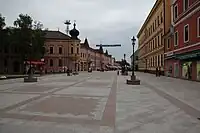| Second Vinkovci Synagogue Druga Vinkovačka Sinagoga | |
|---|---|
 | |
| Religion | |
| Affiliation | Judaism |
| Rite | Ashkenazi |
| Leadership | Rabbi: Mavro Frankfurter |
| Status | Destroyed in 1941-42 |
| Location | |
| Location | Vinkovci, Croatia |
| Architecture | |
| Architect(s) | Fran Funtak |
| Style | Neo-Mudéjar |
| Completed | 1923 |
| Construction cost | 4,5 million Yugoslav krones |
The Vinkovci Synagogue was a synagogue in Vinkovci, Croatia. It was among the largest and the most prestigious synagogues in Croatia.[1]
The Jewish community Vinkovci was established with the arrival of the first Jews in 1873, and the first synagogue was built in 1880. The growth of the Jewish community in Vinkovci, as well as its tangible affirmation in the society, made the first synagogue insufficient. The first initiative to build a new synagogue appeared in 1911. Construction was scheduled to begin as soon as the financial structure was completed and appropriate place was found. World War I postponed the construction. After the war the main problem was financing. Due to the inflation of the Yugoslav krone, community could not finance the construction solely from the contribution of its members. In 1920, the fundraising started, and at that time the Jewish community of Vinkovci had about 200 members, of which 150 lived in Vinkovci and another 50 in the surrounding villages. In the mid-1922, thanks to the persistence and organizational capabilities of rabbi Mavro Frankfurter, the construction of the synagogue started. Jakob Schlesinger, a wealthy wholesaler and the owner of the steam mill in Vinkovci, gave the largest financial contribution to the construction.[1]
The Second Vinkovci Synagogue was built under the architect Frank Funtak in the Aleksandar street (today the Zvonimir street 18–20). The total cost of construction was 4,5 million krones. Funtak turned to classicism when choosing styles for the Vinkovci Synagogue. Although this style dominated, the building also had elements of the 19th-century synagogue architecture and of art deco. The synagogue dome was built in Mudéjar style, while double windows and the trefoil upper row of windows were built in rundbogenstil. Vinkovci Synagogue had a longitudinal construction with a rectangular shape. Funtak took the dome style from the Vukovar Synagogue. In addition to the dome, a tripartite front was a traditional element of the synagogue architecture from the 20th century. The central part of the facade was slightly withdrawn in relation to the side. The sides of the synagogue were visually highlighted with an art deco set of gables above the cornice of the building.[1][2]
Vinkovci Synagogue was destroyed during World War II in 1941-42 by the regime of the Independent State of Croatia. Rabbi Mavro Frankfurter and president of the community Ignjat Lang were both killed in the Jasenovac concentration camp.[1][3][4][5]
References
- 1 2 3 4 (in Croatian) Ha-Kol (Glasilo Židovske zajednice u Hrvatskoj); Druga vinkovačka sinagoga; stranica 35, 36, 37, 38, 39; broj 97, studeni / prosinac 2006.
- ↑ Damjanovic, Dragan (October 2014). Sinagogalne građevine arhitekta Frana Funtaka (Synagogues of the Architect Fran Funtak).
- ↑ (1992-06-21). Globus. Retrieved on 2011-04-30. "Moja baka Terezija Lang i moj djed Ignjat Lang bili su Židovi. Živjeli su u Vinkovcima. On je bio predsjednik Židovske općine, a ona vrlo poštovana domaćica i gospođa predratnih Vinkovaca. Rat su dočekali u Vinkovcima. Godine 1941. fra Hijacint Bošković, jedan od cijenjenih dubrovačkih i hrvatskih dominikanaca, izvanredno se angažirao u pokušaju da ih spasi. S tom je svrhom putovao iz Dubrovnika u Vinkovce. Sa sobom je imao posebnu dozvolu da moga djeda i baku povede u Dubrovnik. Od najranijeg djetinjstva odgajan sam u osjećaju zahvalnosti prema fra Hijacintu, dominikancima i svim fratrima. Nažalost, ponos cijele obitelji, moj djed, odbio je napustiti Vinkovce, rekavši fra Hijacintu: "Bio sam predsjednik Židova u miru i ostat ću to i u ratu." Već sam prije opisao kako je ubijen. Moja baka, zajedno s njim, odvedena je u koncentracioni logor, premda je već bolovala od zloćudne bolesti. U logoru joj, međutim, nisu dopustili ni da umre od te bolesti, nego su je na strašan način ubili."
- ↑ "Slobodan Lang intervju". www.veritas.hr (in Croatian). Veritas. Archived from the original on 2012-03-15. Retrieved 2013-07-09.
- ↑ "U Hrvatskoj nije prepoznato dobro". www.matica.hr (in Croatian). Matica hrvatska.
Sources
- Damjanović, Dragan (June 2005). "Židovske vjerske građevine vukovarskog inženjera Frana Funtaka" [Jewish Religious Buildings Designed by the Engineer Fran Funtak] (PDF). Prostor: A Scholarly Journal of Architecture and Urban Planning (in Croatian). Faculty of Architecture, University of Zagreb. 12 (2). ISSN 1330-0652. Retrieved 10 December 2012.
